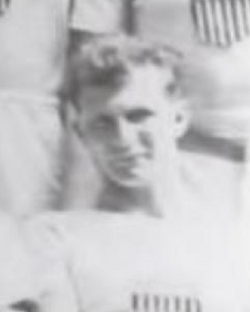Joseph Erxleben
 Erxleben in 1912 | |
| Personal information | |
|---|---|
| Nationality | American |
| Born | September 15, 1889 |
| Died | August 29, 1973 (aged 83) |
| Sport | |
| Sport | Running |
| Event | Marathon |
| Club | Missouri Athletic Club |
Joseph John Erxleben (September 15, 1889 – August 29, 1973) was an American long-distance runner who competed in the marathon at the 1912 Summer Olympics in Stockholm.[1]
Pre-Olympic accomplishments
[edit]Erxleben was from St. Louis, Missouri[2][3] and competed for the Missouri Athletic Club.[4] He had a younger brother, Hermann, who was reported to have won a five-mile "junior marathon" at the age of 16.[5]
Erxleben won a 15-mile race at a meet in the St. Louis Coliseum hosted by Saint Louis University on February 13, 1909.[4] On May 1, 1909, running "against a cold head wind", he finished over six minutes ahead of Alexander Thibeau to win the Missouri Athletic Club's All-Western Marathon in a time of 2:49:10.4.[4] Erxleben finished five seconds behind L. J. Pillivant as the runner-up in the sixth edition of the same race on May 14 of the following year,[6] but beat Joseph Forshaw to win the Missouri AC event for a second time in 1911.[7]
In March 1912, Erxleben was one of "twenty of the best distance runners in the middle west" scheduled to participate in a 20-mile indoor marathon at Riverview Rink in Chicago, Illinois.[2]
1912 Summer Olympics
[edit]For the third time in four years, Erxleben again won the 25-mile Missouri Athletic Club marathon in St. Louis on May 4, 1912 to earn a spot on the United States Olympic Team.[8][9] Posting a time of 2:36:30, he finished ahead of runner-up Forshaw with Sidney Hatch in third.[8][9][nb 1] According to The Washington Times, Erxleben was also selected by the United States Olympic Committee to represent the team in the 10,000 meters flat,[11] but there is no record in the official report of the 1912 games that he participated in the event.[12]
Conditions for the marathon at the 1912 Summer Olympics run on July 14, 1912, have been described as "very hot" and even "horrific", with only half of the 68 starters finishing the race.[8][9] Late in the race, seven Americans ran in the top twelve positions, including Erxleben in ninth, resulting in one report to suggest that they may have acclimatized better to the heat than the Northern European competitors.[9] Erxleben finished in eighth place, the fourth American, with a time of 2:45:47.2.[9] He was one of 42 American Olympians who returned to New York aboard the Red Star Line ocean liner Vaderland on July 31, 1912.[13]
Notes
[edit]- ^ The Association of Road Racing Statisticians notes that Erxleben's performance in St. Louis on May 4, 1912 was the seventh fastest over 40km or 25 miles that year.[10]
References
[edit]- ^ "Joseph Erxleben". Olympedia. Retrieved 21 April 2021.
- ^ a b "They've Revived It: We Thought the Marathon Game Was Dead and Buried but Not Yet". The Milwaukee Journal. Milwaukee. March 8, 1912. p. 13. Retrieved April 29, 2012.
- ^ Cooper, Pamela (1999). "The New York City Marathon Culture". The American Marathon. Syracuse, New York: Syracuse University Press. p. 46. ISBN 9780815605737. Retrieved April 29, 2012.
- ^ a b c Sullivan, J.E., ed. (January 1910). "Marathon Road Races". Spalding's Official Athletic Almanac for 1910. Vol. XII. New York: American Sports Publishing Co. pp. 91, 205, 215. Retrieved April 29, 2012.
- ^ "Two Thousand Boys Enter Junior Marathon Contest". The Bakersfield Californian. Bakersfield, California. May 15, 1909. p. 6. Retrieved April 29, 2012.
- ^ "Chicagoan Wins Marathon" (PDF). The San Francisco Call. San Francisco. May 15, 1910. p. 49. Retrieved April 20, 2012.
- ^ O'Shaughnessy, Christine Forshaw (May 2004). "Joseph Forshaw, Marathon Runner" (PDF). Journal of Olympic History. 12 (2). International Society of Olympic Historians: 17. Retrieved April 30, 2012.
- ^ a b c USA Track & Field (2004). "2004 USA Olympic Team Trials: Men's Marathon Media Guide Supplement" (PDF). Santa Barbara, California: USA Track & Field. pp. 7, 11. Retrieved April 29, 2012.
- ^ a b c d e Martin, David E.; Gynn, Roger W.H. (2000). "1912: A South African Success Spree in Stockholm". The Olympic Marathon. Champaign, Illinois: Human Kinetics Publishers. pp. 82–83, 89–90, 92. ISBN 9780880119696. Retrieved April 29, 2012.
- ^ "World Marathon Rankings for 1912". Association of Road Racing Statisticians. February 3, 2012. Retrieved April 30, 2012.
- ^ "America's Olympic Athletes Chosen: List of Those to Represent the United States at Stockholm Is the Most Impressive Array United States Has Ever Assembled" (PDF). The Washington Times. Washington, D.C. June 11, 1912. p. 13. Retrieved April 30, 2012.
- ^ Bergvall, Erik, ed. (December 1913). The Fifth Olympiad: The Official Report of the Olympic Games of Stockholm 1912 (PDF). Stockholm: Wahlström & Widstrand. pp. 368–371, 382–390. Archived from the original (PDF) on 2008-04-10. Retrieved April 30, 2012.
- ^ "Olympic Athletes Welcomed Home: Forty-two of the Victorious American Team Arrive on the Vaderland" (PDF). The New York Times. New York. August 1, 1912. Retrieved April 29, 2012.[dead link]
External links
[edit]- Evans, Hilary; Gjerde, Arild; Heijmans, Jeroen; Mallon, Bill; et al. "Joseph Erxleben". Olympics at Sports-Reference.com. Sports Reference LLC. Archived from the original on 2020-04-18.
- Joseph Erxleben at Olympedia
